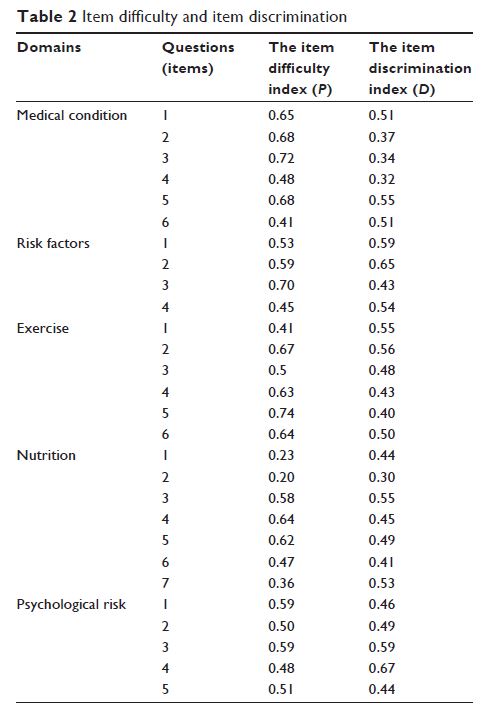108605
论文已发表
注册即可获取德孚的最新动态
IF 收录期刊
- 3.4 Breast Cancer (Dove Med Press)
- 3.2 Clin Epidemiol
- 2.6 Cancer Manag Res
- 2.9 Infect Drug Resist
- 3.7 Clin Interv Aging
- 5.1 Drug Des Dev Ther
- 3.1 Int J Chronic Obstr
- 6.6 Int J Nanomed
- 2.6 Int J Women's Health
- 2.9 Neuropsych Dis Treat
- 2.8 OncoTargets Ther
- 2.0 Patient Prefer Adher
- 2.2 Ther Clin Risk Manag
- 2.5 J Pain Res
- 3.0 Diabet Metab Synd Ob
- 3.2 Psychol Res Behav Ma
- 3.4 Nat Sci Sleep
- 1.8 Pharmgenomics Pers Med
- 2.0 Risk Manag Healthc Policy
- 4.1 J Inflamm Res
- 2.0 Int J Gen Med
- 3.4 J Hepatocell Carcinoma
- 3.0 J Asthma Allergy
- 2.2 Clin Cosmet Investig Dermatol
- 2.4 J Multidiscip Healthc

中国版冠状动脉疾病教育问卷-II (CADEQ-II):翻译和验证
Authors Chen Z, Geng J, Wang M, Hu L, Ghisi GLM, Yu HD
Received 8 June 2018
Accepted for publication 26 July 2018
Published 27 August 2018 Volume 2018:12 Pages 1587—1596
DOI https://doi.org/10.2147/PPA.S176639
Checked for plagiarism Yes
Review by Single-blind
Peer reviewers approved by Dr Amy Norman
Peer reviewer comments 3
Editor who approved publication: Dr Naifeng Liu
Objectives: It is necessary to assess disease-related knowledge in patients with coronary artery disease (CAD) for tailored patient education; however there is a lack of a well-validated measurement in China. The objective of this study was to translate and validate a Chinese version of the Coronary Artery Disease Education Questionnaire-II (CADEQ-II).
Methods: The Chinese version of CADEQ-II was translated and culturally adapted. Then, it was tested for psychometric properties through a convenient sampling. Content validity was examined based on a panel of five experts. The item difficulty index and item discrimination index were calculated to assess the item difficulty and item discrimination. Internal consistency reliability was measured with the Cronbach’s alpha coefficient. Criterion-related validity was established through comparing scores in patients with different education levels. Construct validity was assessed through confirmatory factor analysis (CFA).
Results: The Chinese version of the CADEQ-II was finalized after deleting three items and modifying two items from the original version. Three hundred and sixteen participants completed the whole questionnaire. Content validity index of the whole questionnaire was 0.87. The Cronbach’s alpha coefficient of the overall questionnaire was 0.907. The significant difference of the knowledge scores among patients with different education levels supported criterion-related validity. CFA confirmed the proposed four-factorial structure of the questionnaire.
Conclusion: The Chinese version of CADEQ-II had an acceptable reliability and validity among Chinese patients with CAD. It could be used to develop individualized health education for Chinese patients with CAD. Also, it could serve as a suitable outcome measurement to evaluate the effectiveness of education interventions related to CAD.
Keywords: coronary artery disease, education, validation
